New Videos and Audio
[watch] Nancy and Joel's "Big Ideas One" Interview with Gavin Scott
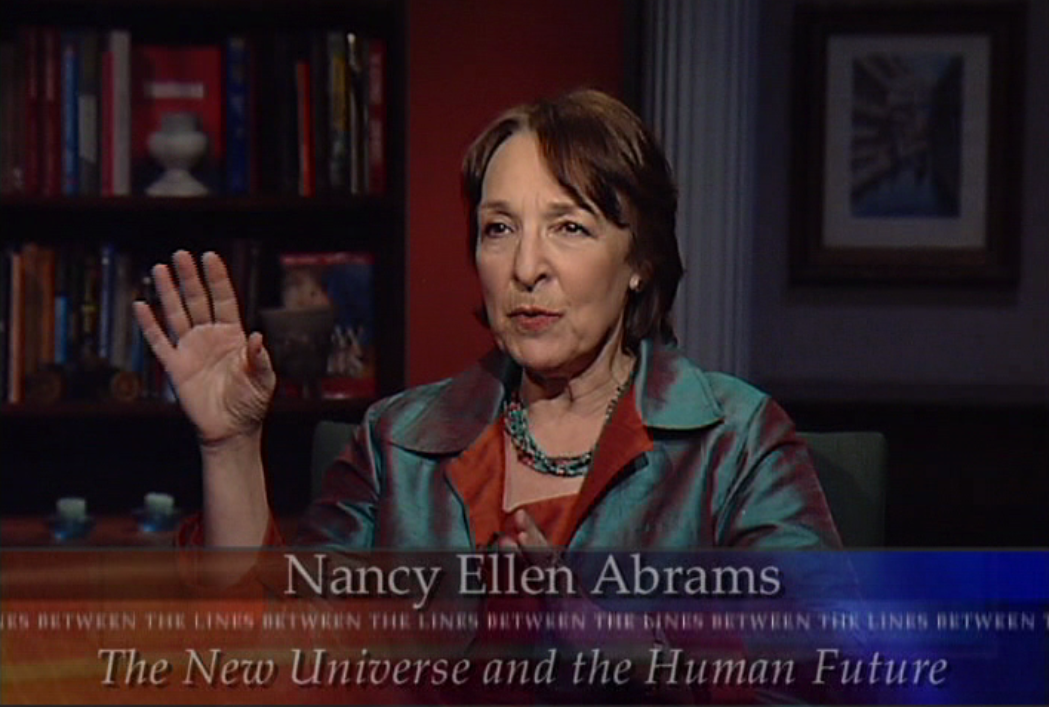
[watch] Nancy's "Between the Lines" Interview with Barry Kibrick for PBS-TV
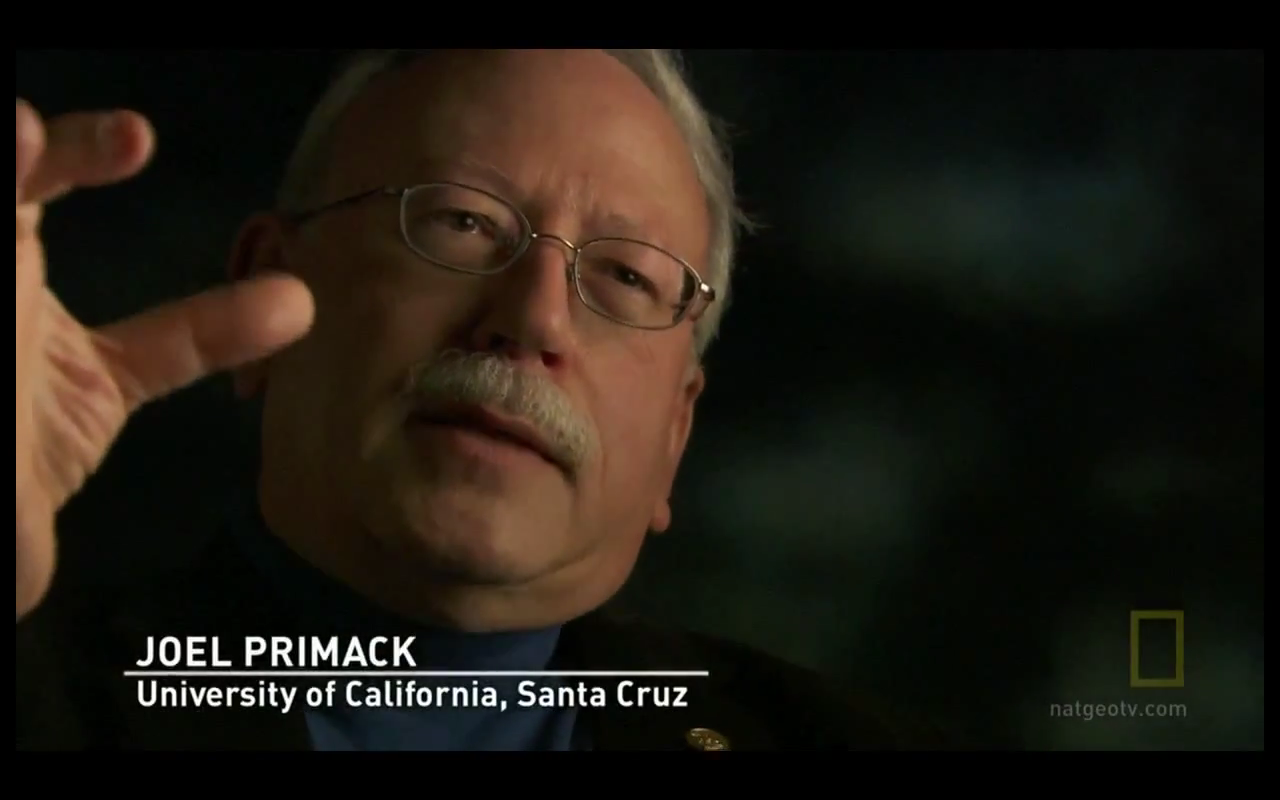
[watch] Joel explains dark matter
[watch] Joel explains dark matter, with Spanish subtitles
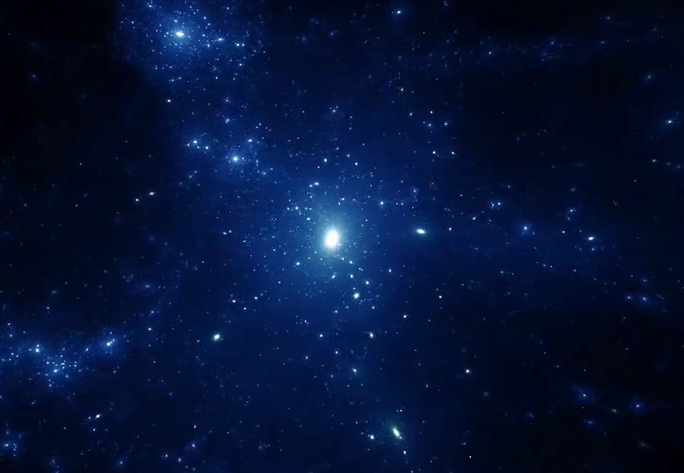
[explore] Joel is Principal Investigator of the Bolshoi project, which has produced the most accurate simulations yet of the large scale structure of the universe. This is the link for videos, images, articles, and more on the Bolshoi simulations and their implications.
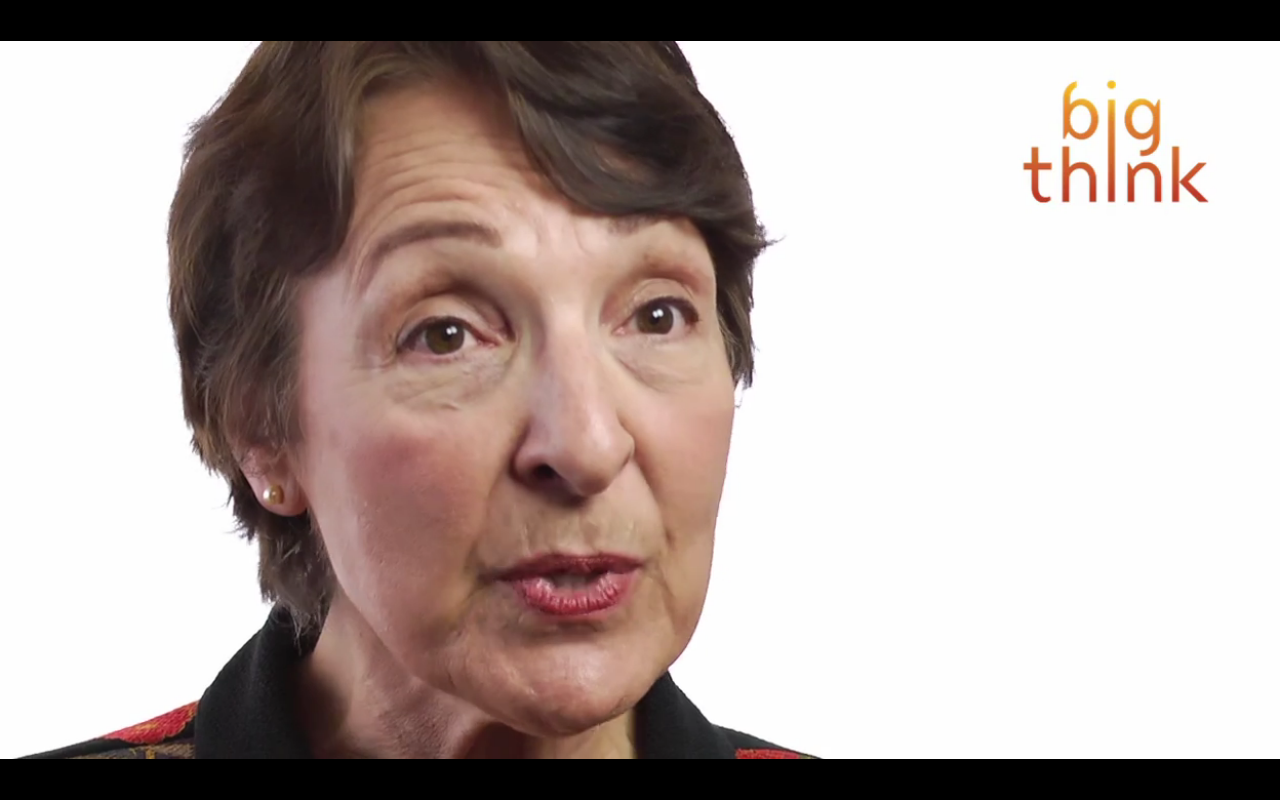
[watch] "The Big Think" talks with Nancy and Joel. Please note that Nancy is a a lawyer, philosopher, writer, and the co-author of The New Universe and the Human Future and The View from the Center of the Universe and not, as listed in this video, a Professor of Philosophy at UC, Santa Cruz.
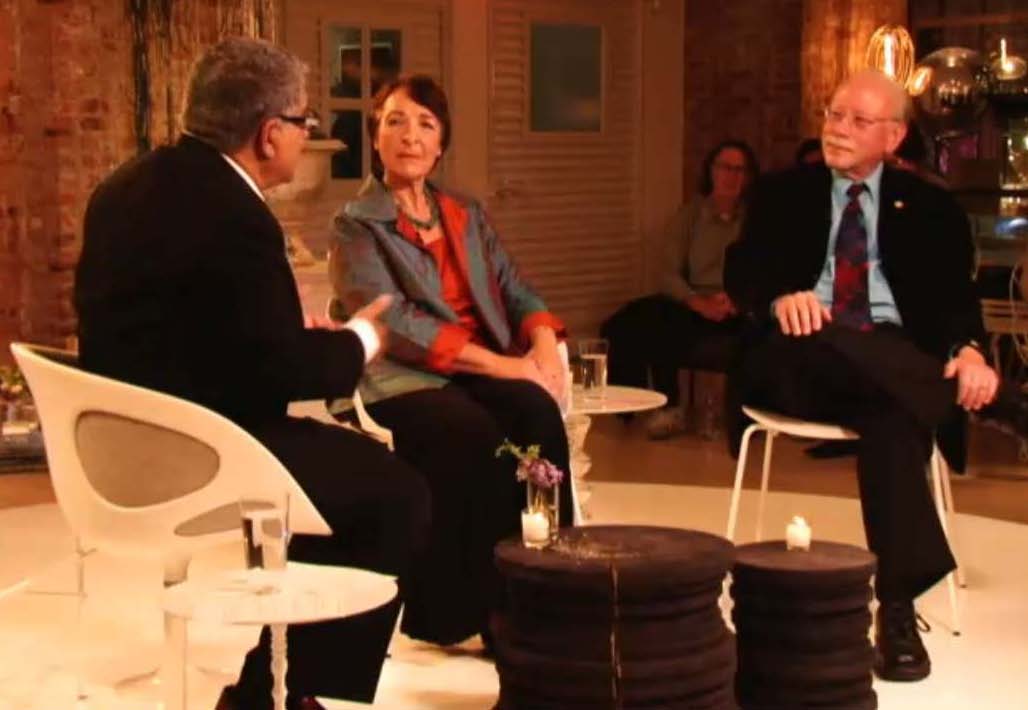
[watch] "Deepak Chopra in televised conversation with Nancy and Joel, Nov. 17, 2011"
[listen] "Deepak Chopra radio interview with Nancy and Joel, Oct. 27, 2011"
New Features
[view]Resurgence Magazine: "Cosmic Consciousness in the Real World" by Nancy Ellen Abrams, June / July 2012
[view & listen]WritersCast.com: "Joel Primack and Nancy Abrams: The New Universe and the Human Future" by David Wilk, June 3rd, 2012
[view]Contemporary Review: "New Cosmology and God's Universe" by Charles Foster, March 2012
[view]HOPE: "Expanding Inner and Outer Space" by Mara Senese, March 6th, 2012
[view]The Soul of Star Trek Blog (one of the top 10 Star Trek blogs according to Craigslist and the Guardian): "The Universe and Star Trek," August 10, 2011
[view]22C+: "New Cosmos, New Wisdom?" by Marcus T. Anthony, November 12, 2011
[view]Santa Cruz Sentinel: "Santa Cruz scientists Joel Primack and Nancy Abrams win Chopra award" by Wallace Baine, January 12, 2012
[view]SantaCruz.com: "UCSC Profs Win Chopra Award" by Traci Hukill, January 17, 2012
Cosmic Consciousness in the Real World
by NANCY ELLEN ABRAMS
nancyellenabrams.com
June / July 2012
When I was in my twenties I read a book called Cosmic Consciousness by a 19th-century psychiatrist named Richard M. Bucke. Dr Bucke had had an amazing vision that descended on him out of the blue. It only lasted a few moments, but he spent the rest of his life trying to understand what had happened. In his book he described it as an overwhelming sense of "oneness with the cosmos", utter "exaltation", and "intellectual illumination" that felt absolutely real yet completely blissful... read full aricle.
Joel Primack and Nancy Abrams: The New Universe and the Human Future
by DAVID WILK. WritersCast
writerscast.com
June 3rd, 2012
This was an exciting and extraordinary book for me to take on. At the very moment I discovered Joel Primack and Nancy Abrams’ cool new book The New Universe and the Human Future, I was also discovering Big History and working on a book project that relates exactly to the ideas in this book. So it was a lucky coincidence for me to find this book and even better to have the chance to speak with the authors. My first two-author interview also, which was fun, not the least because Joel and Nancy work brilliantly together... read full aricle & listen here.
New Cosmology and God's Universe
by CHARLES FOSTER, Fellow of Green Templeton College, University of Oxford. Contemporary Review
contemporaryreview.co.uk
March 2012
By weight, we are 90 per cent stardust and 10 per cent hydrogen. The iron atoms in our haemoglobin came mostly from exploding White Dwarfs. When we look up at the light from distant galaxies we are seeing something that has not existed for perhaps a billion years.
In terms of physical size, everything there is has to be about the size it is, because of how physical laws act on objects. We humans are at the centre of all possible sizes. We are at the centre of several other things, too. We are halfway through the lifetime of our sun, and at the midpoint of the existence of complex life on earth. Biological complexity has been around for about a billion years. It will last about another billion years, and then the earth will become a desert. We are uniquely positioned to appreciate our own place in the cosmos. This is the best time that there ever has been or ever will be for astronomical observation. Never again will there be so many galaxies visible. The expansion of the universe has accelerated, and the most distant galaxies will shortly vanish for ever over the horizon.
We're exhilaratingly favoured and yet we carry on shuffling, with our eyes to the ground. Some cling desperately to old models of existence, as hopelessly out of date as the ancient Egyptian notion that the god Geb, whose body is the flat earth, is prised by the sky from his sister-lover Nut, whose body is embedded with the stars. But most have no model at all, or a model so eclectic that there is no one to share it with.
Our cosmological conservatism is striking. Until very recently it was thought that the Milky Way was the Universe. The eighteenth century astronomer William Herschel mapped it. It was all very cosy. And then something vertiginous happened. In 1924 Edwin Hubble discovered that some of the nebulae that Herschel had placed in the Milky Way were actually galaxies massively far outside it. Our galaxy was suddenly just one amongst billions. There was every reason to feel small and afraid.
By and large, however, we do not. That, perhaps, is because we do not allow ourselves to feel anything at all, or to look hard enough at the queasy facts that would force us to feel. If we try to justify ourselves, we typically say that fact and meaning are separate. Religion conspires in this deception. This is historically understandable. When Galileo was persecuted by the church for his cosmological observations, scientists (for instance Descartes) adopted a policy of non-interference with religion. This was to save their own skins, not because they had reasoned their way to the conclusion that science and religion were non-overlapping magisteria. This suited the religious establishment too: it protected religion from the embarrassment of its assertions being contradicted by scientific advance.This convenient but cowardly detente persists. But it can no longer be sustained.
Humanity is in an unusual position. The old certainties of literalistic religion have, for most people, evaporated. In the past, everyone knew how he fitted into the big cosmic picture. Now there is either semi-sublimated doubt or sheer wackiness. This is the background of Nancy Abrams and Joel Primack's magnificent, passionate and urgent book. They contend that knowledge of our context — of our intimate relations with the stars, of the immense antiquity of the visible universe, of the mysterious interplay of the invisible Dark Matter and Dark Energy that shape everything, of our privileged place on this very special planet - can make us feel properly at home 'in the universe; can give us a sense of belonging and relevance. For them, it is not that myth and fact can and should co-exist: it is that they are, vitally and liberatingly, one and the same. For them, cosmology and ontology cannot be divided without great and damaging violence. But this is no reductionist tract. There is no call to sling out the religious mindset, but simply to inform it with the facts. The book is suffused with awe, humility and concern.
The descriptions of immensely complex scientific ideas are always lively and accessible. They are supplemented by superb illustrations. If this were simply a textbook of modem cosmology, it would be splendid. But it is much more than that. It is a call (not a hectoring, preachy call, but a call nonetheless), to act on what we know, before it is too late. For there is yet another reason why this is a crucial time in human history: for the first time ever we have the power to destroy our planet. Nancy Abrams and Joel Primack give us some good reasons why we should not do so, and suggest some mechanisms for avoiding disaster. H.G. Wells once wrote: 'Human history becomes more and more a race between education and catastrophe.' Quite right. Catastrophe seems at the moment to be ahead, but this book can help to narrow the gap.
Expanding Inner and Outer Space
by MARA SENESE, HOPE
http://hopevolution.org/
March 6, 2012
I am becoming more and more aware that the key movement in these times is the expansion of our thinking and awareness – on many levels. Don’t miss the two videos in this post- they are definitely mind stretching – or is mind blowing !
Keep your eyes open for articles about new discoveries, experiments and explorations in space. The photos coming from NASA – like this Nebula pictured here – are beautiful and haunting. New theories about our Cosmology are all over the main-stream newspapers, but are not often translated into what these discoveries mean to us as human beings or our understanding of who we are and where we are!
According to one blog that I read, “We are currently experiencing a paradigm shift in scientific thinking and explanation, away from reductionist and constructivist approaches. This shift is the result of the introduction of computers and the internet. Scientific researchers are now capable of collecting and processing much more information than ever before, and advanced modeling techniques allow them to develop and test scientific theories in ways that were simply not possible 20 or even 10 years ago.”
Joel R. Primack & Nancy Ellen Abrams gives us some clues about all this in their highly acclaimed books. I have only read articles about their work but have been fascinated with it since 2008. Their new book The New Universe and the Human Future gives us a fresh and exciting view of the beauty of the Universe and the potential role that we, as humans, have in these times. The website for this book is full of fascinating articles, interviews, reviews and stunning photographs from outer space. It is worth spending some time there. You will leave amazed and refreshed. A review of the book calls it poetic, demanding, grounded, soaring, empowering, and always awe-inspiring ...read full article
Star Trek and the Cosmos
by CAPITAN FUTURE, The Soul of Star Trek
http://soulofstartrek.blogspot.com/2011/08/universe-and-star-trek-star-trek-in-its.html
August 10, 2011
Star Trek in its Roddenberry Era stories worked hard to keep up with scientific discoveries about the universe, as well as the more advanced theories. But Capitan Kirk's 23rd century was based on views of the universe from over 40 years ago, and Picard's 24th century on the universe as known or theorized about a quarter century ago.
But according to a new book, The New Universe and the Human Future by Nancy Ellen Abrams and Joel R. Primack (Yale Univ. Press), the astronomers' and physicists' knowledge of the universe (or "scientific cosmology") has advanced a great deal since the end of the 20th century. So how does our shared Star Trek universe hold up?
I don't mean Trek's strange new worlds and new civilizations -- none of those have been found, despite the evidence of hundreds of planets around other stars. But in how the universe works, and what's in it?... read full article
New Cosmos, New Wisdom?
by MARCUS T. ANTHONY, 22C+
http://22cplus.blogspot.com/
November 12, 2011
Santa Cruz scientists Joel Primack and Nancy Abrams win Chopra award
by WALLACE BAINE, Santa Cruz Sentinel
http://www.santacruzsentinel.com/
January 12, 2012
Astrophysicist Joel Primack and writer/philosopher Nancy Ellen Abrams of Santa Cruz have both been named recipients of the 2012 Rustum Roy Spirit Award by the Chopra Foundation, under the direction of best-selling author and doctor Deepak Chopra.
The Roy Award is given to those "making major contributions to the scientific understanding of consciousness and helping to move humanity toward a just, sustainable, healthy and peaceful world."
Primack and Abrams, who will share the honor with neurologist Rudolph Tanzi, will be on hand to receive the award at the International Sages and Scientists Symposium March 3-5 in Carlsbad. The award carries a $100,000 prize.
Primack is Distinguished Professor of Physics at UC Santa Cruz and the director of UC's High-Performance Astro Computing Center. Abrams is a writer and scientific philosopher who has worked in science policy for the U.S. Congress and the government of Sweden.
The husband-and-wife team are co-authors of the 2006 book "The View from the Center of the Universe" as well as their latest work, 2011's "The New Universe and the Human Future," in which they blend new discoveries in astrophysics and cosmology with possibilities about the destiny of the human race... read full article
UCSC Profs win Chopra Award
by TRACI HUKILL, SantaCruz.com
http://www.santacruz.com
January 17, 2012
The message came out of nowhere last fall from a secretary at the Chopra Foundation in Carlsbad, Calif. Deepak Chopra wished to speak to them. Would it be all right if he called?
UCSC professors Nancy Ellen Abrams and Joel Primack—she’s a philosopher, he’s an astrophysicist—aren’t your standard readers of Chopra, whose 60–odd published books include titles like Ageless Body, Timeless Mindand Manifesting Good Luck Cards: Growth and Enlightenment. Chopra, however, had become a reader of Abrams and Primack. Their books on cosmology, The View from the Center of the Universe and The New Universe and the Human Future,had made an impression on him, and he wanted to get the word out. Pending his board’s approval, he would be awarding them part of a $100,000 prize known as the Rustum Roy Spirit Award, given by the Chopra Foundation “to those making major contributions to the scientific understanding of consciousness.”
“I didn’t even know it existed!” says Abrams of the prize, which was formally awarded to the couple and to Alzheimer’s researcher Dr. Rudy Tanzi last week. “It was out of nowhere.”
The couple’s books present a view of the cosmos and humankind’s unique place in it that effectively makes the case for a science-based spirituality with roots in a shared cosmology—crucial, they argue, for a planet facing dire problems like climate change... read full article

